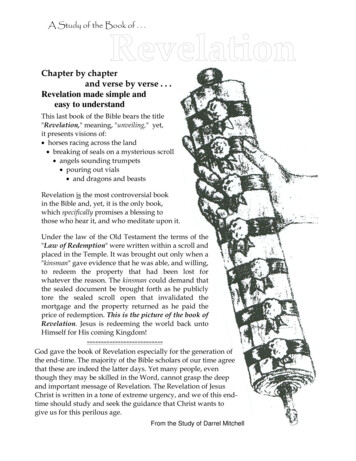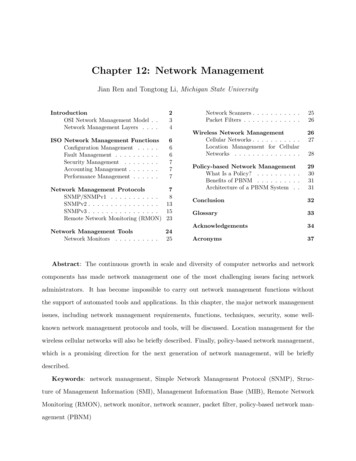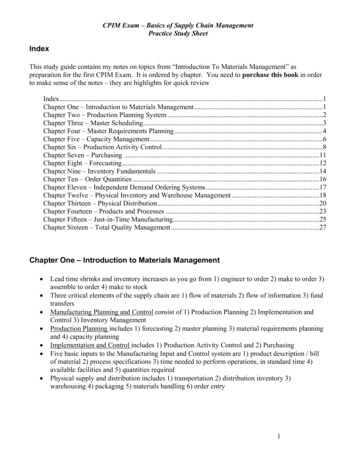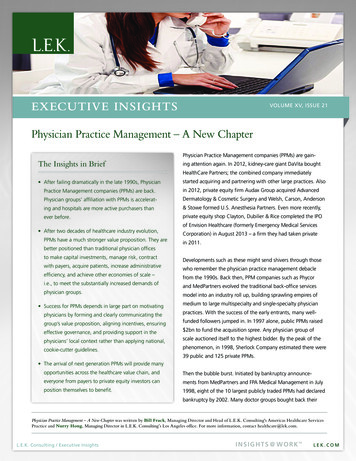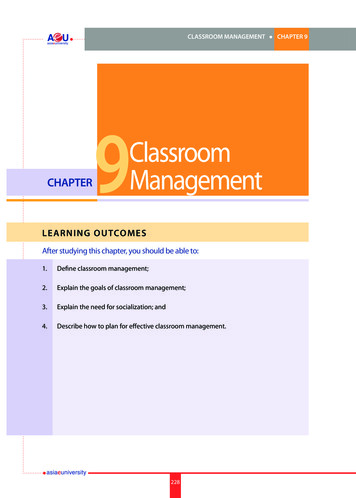
Transcription
CLASSROOM MANAGEMENTCHAPTER9ClassroomManagementLE ARNI NG OUTCOMESAfter studying this chapter, you should be able to:1.Define classroom management;2.Explain the goals of classroom management;3.Explain the need for socialization; and4.Describe how to plan for effective classroom management.228lCHAPTER 9
CHAPTER 9lCLASSROOM MANAGEMENTINTRODUCTIONWhat did you think about theteacher’s role in a classroom?The answer for the question is there are two dominant roles played by a teacher in a classroomas illustrated in Figure 9.1.i.Figure 9.1: Two dominant roles of teacher in a classroomThis chapter concerns with the second of these two aspects of learning that is the issuesassociated with the instruction process. The chapter focuses in particular on how teachersmanage the classroom activities and the strategies they use to ensure that the classroomprovides a context to support and facilitate learning. Managing a class full of students is229229
CLASSROOM MANAGEMENTlCHAPTER 9one of the biggest challenges faced by teachers. If teachers do not have an effective planin place, there will not be much opportunity for students to engage in meaningful learningexperiences. Thus, teachers will find themselves refereeing instead of teaching.Research shows that a high incidence of classroom disciplinary problems has a significantimpact on the effectiveness of teaching and learning. In this respect, it has been foundthat teachers facing such issues fail to plan and design appropriate instructional tasks.They also tend to neglect variety in lesson plans and rarely prompt students to discuss orevaluate the materials they are learning.According to Froyen, L. A., & Iverson:9.1Definition of Classroom ManagementClassroom management is a term used by teachers to describe the process of ensuringthat classroom lessons run smoothly despite disruptive behaviour by students. The termalso implies the prevention of disruptive behaviour.230
CHAPTER 9lCLASSROOM MANAGEMENTAccording to Bellon, Bellon & Blank:“The term ‘classroom management’ and ‘discipline’ are often used interchangeably”.(Bellon, Bellon, & Blank, 1992)However, too often the term ‘discipline’ focuses on misbehaviour, ill deeds, and punishmentand contains two significant limitations as shown in Figure 9.2.FirstSecondDisipline highlight onindividual ratherthan classroom.It connotes negativebehaviour only.Figure 9.2: Two significant limitations in term of ‘ discipline’.Whereas, classroom management is the term we will use to highlight all of those positivebehaviours and decisions teachers make to facilitate the learning process of their students.It refers to all those activities necessary to create and maintain an orderly learningenvironment such as planning and preparation of materials, organization, decoration of theclassroom and certainly the establishment and enforcement of routines and rules (Tan,Parsons, Hinson, & Sardo-Brown, 2003).In short, classroom management can be defined as:Classroom management is teachers’ strategies that createand maintain an orderly learning environment and disciplinemeans teachers’ responses to student’s misbehaviour.Or also also defined as:Classroom management is closely linked to issues ofmotivation, discipline and respect.231i.231
CLASSROOM MANAGEMENTlCHAPTER 9Many teachers establish rules and procedures at the beginning of the school year. They alsotry to be consistent in enforcing these rules and procedures. Many would also argue forpositive consequences when rules are followed and negative consequences when rules arebroken. There are newer perspectives on classroom management that attempt to beholistic. One example is affirmation teaching, which attempts to guide students towardsuccess by helping them see how their effort pays off in the classroom. It relies uponcreating an environment where students are successful as a result of their own efforts.According to specialists in the field of education:“School and classroom management aims at encouraging and establishingstudent self-control through a process of promoting positive student achievementand behaviour. Thus academic achievement, teacher efficacy, and teacher andstudent behaviour are directly linked with the concept of school and classroommanagement.”(Froyen, L. A., & Iverson, A. M., 1999)Where as according to Doyle, 1986 (as cited in Krause, Bouchner & Duchesne, 2003):“Classroom management is certainly concerned with behaviour, but it can alsobe defined more broadly as involving the planning, organization and controlof learners, the learning process and the classroom environment to create andmaintain an effective learning experience.”(Krause, Bouchner & Duchesne, 2003)The classroom environment not only provides a context for learning and includes thephysical space, furnishings, resources andmaterials, but also the class atmosphere,participants’attitudes and emotions, and thesocial dynamics of the learning experience.1. What is classroom management?2. How do you differentiate classroom management from discipline?232
CHAPTER 99.2lCLASSROOM MANAGEMENTGoals of Classroom ManagementA well-organized classroom is a classroom in which students know how to effectively makeuse of the classroom and its resources. Some of the teaching objectives focus on expectedacademic behaviours, appropriate use of materials and learning centres, and cooperationwith peers. So, teacher should play a role to create a community of learners wherestudents play an active part in forming their environment, understand their role students,and learn how to work effectively as an individual and with peers. All actions takenby the teacher should be focused on minimizing disruptions and fostering an environmentwhere students can learn.The goals of classroom management can be many, but, the two common goals ofclassroom management are as shown in Figure 9.3.classroomThe goals oftmanagemenve,in a posititainamdna To createnment.arning enviroleeivctproduoma safe classrorestfodna To supportcommunity.Figure 9.3: Goals of classroom management.233i.233
CLASSROOM MANAGEMENTlCHAPTER 9The goals of classroom management are elaborated as below.(a) To create and maintain a positive, productive learning environment.This goal is not meant for absolute control or to createan inert, docile, and totally compliant classroom andstudent body. Rather, an effective classroom management is to maintain students’ interest, motivation andinvolvement. Thus, the focus is on activities that createpositive, productive and facilitative learning environment.(b) To support and foster a safe classroom community.Another goal of classroom management is to support and foster a safe classroom community. It means that students are allowed to make the connections needed for learning to takeplace. Each student needs to feel comfortable enough to discuss their previous understanding without fear of being ridiculed for their misconceptions. In order to make the studentscomfortable enough to take these intellectual risks, it is necessary to set up the rules androutines which: The rules and routines will give them a structure in which to interact with the teacherand each other.The rules and routines need to be necessary, fair and specific if the students are to beexpected to follow them.Each rule or routine should come with a verbal or written description of why therule is needed. If the rule is too vague on its own, examples should be given.Classroom management strategy will not work if a teacher does not know his/her students. Ifthe teacher takes the time to get to know the students, he or she can not only plan managementissues better, but can also minimize disruptions in a more personal way. This has the addedbenefit of letting the students know that you care about them as people as well as students.Figure 9.4 lists some of the aims of effective classroom management plan.Effective classroom management plan. To assist students to keep task focus. Research demonstrates a significantrelationship between the amount of content covered and student learning(Berliner, 1988). To reduce distraction from learning. This is an extension of the goal to keepstudent task focused. To organize and facilitate the flow of learning activities. Assess to learning isassisted by the development of rules and routines that increase involvement234
CHAPTER 9lCLASSROOM MANAGEMENTand participation. Therefore, management goal must complement learning goal. To help the students to manage themselves. That is, to assist students to takeresponsibility for their own actions as they impact their work within the classroom.(Tan, Parsons, Hinson, & Sardo-Brown, 2003).Figure 9.4: The aims of effective classroom management plan.9.3Managing Behaviour9.3.1The Need for ‘Socialization’The purpose of classroom management is socializing students with the ‘dos’ and ‘don’ts’behavioural in the school’s environment. Meaning that, it teaches children how to behavein ways that facilitate learning. The teacher should understand that children’s behaviour isnot automatic. In fact, in many ways, the behaviour we request of children as member ofour classes could be contrary to their natural inclinations. Look at the examples stated inFigure 9.5.i.Teacher cannot expectthat a healthy six orseven years old childrenwith all their energyand enthusiasm, to sitat their desks or to bequiet, or wait to berecognized before speaking in a natural and automatic ways.Teacher cannot expectthattheadolescent,secondary school students to be automatically and naturally attendonly to the teacher andrestrain from passingnotes, speaking to neighbours or laughing atthe noises coming fromthe back.Figure 9.5: Example of requesting behaviour could be contrary to the student’s natural inclinationsAll those behaviours are not terrible acts. But to attend to the proper classroom and to maintain academic focus and attention, students have to behave in ways that are often desired,encouraged and often appropriate in the context of learning. Like other lessons to be learned,these behaviours need to be taught, not simply demanded.Tan, Parsons, Hinson, & Sardo-Brown indicated that:235235
CLASSROOM MANAGEMENTlCHAPTER 9The process of socializing the students is known as “schooliszation”.(Tan, Parsons, Hinson, & Sardo-Brown, 2003)9.3.2Disruptive and Disturbed BehaviourIn most classrooms, students’ behaviour is generally appropriate and does not present achallenge to the teacher. However, there are sometimes a few children whose behaviour isat times inappropriate, nuisance and difficult to manage that teacher needs to seekadditional help from experts, either to develop better strategies for coping with particularstudents or to find some other solutions.Disruptive behaviour can be defined as:Disruptive behaviour is the behaviour that is problematic or inappropriatein the context of a given activity or for a certain teacher.In other words, disruptive behaviour is the behaviour that interferes with students’ ownlearning or disrupt the class, in school settings. It is also called as problematic behaviour,such daydreaming, drowsiness, wriggling, mild interruptions, unnecessary and excessivemovement, or those that disrupt the flow of activity for the whole group such as callingout, arguing, shouting, swearing, fighting and so on. Over time, most teachers develop236
CHAPTER 9lCLASSROOM MANAGEMENTstrategies for responding to disturbance caused by such behaviours.An important element of the classroom management process concerns the range ofbehaviours that may be present in a particular group of students, and the identification andimplementation of appropriate strategies for handling these behaviours as shown inFigure 9.6.Figure 9.6: Two elements of the classroom management process.1. Jog down what are some of the goals of effective classroommanagement?2. What behaviour does you categories as disruptive or problematicin classroom?3. Compare your lists with those of others in your group and discusstrategies for dealing with disruptive and problematic behaviour.4. Do you have concerns about managing disruptive behaviour in yourclassroom? If so, identify ways of addressing your concerns anddiscuss it with your friend.9.4Managing ClassroomManaging student’s behaviour is clearly a complex process. Teachers must be multiskilled, talented and able to deal with range of behaviour. Different behaviourmanagement strategies were used in classroom. One of the strategies was corporalpunishment. But, it was not allowed to be used or became the last resort in many countriesall around the world. Therefore, corporal punishment has been replaced by alternativeforms of discipline, which ranges from detention, extra written work, time out, removalof privileges, behaviour contracts or agreements, in-school suspension and communityservice to exclusion and expulsion (Youthlaw, 2003 as cited in Krause, Bochner, &Duchesne, 2003).237i.237
CLASSROOM MANAGEMENTlCHAPTER 9In order to be successful in teaching, teachers need to have a planning for effectiveclassroom management. There are six suggested planning for teachers to effectivelymanage a classroom as illustrated in Figure 9.7. The planning include reflecting studentdevelopment needs, creating a physical environment, creating a learning environment,creating, teaching and maintaining rules and procedures, managing the classroomactivities, getting students to cooperate and classroom management style.Students’development levelor Studentcharacteristics.Classroommanagement style.Creating, teachingand maintain rulesand procedures.Creating a physicalenvironment.Planning foreffectiveclassroommanagement.Creating a learningenvironment.Effectively managingthe classroomactivities.Getting students’cooperation.Figure 9.7: Planning for effective classroom managementThe descriptions for the planning are explained below.(a) Reflecting students’ development needs: Students’ characteristic.As a process of appropriate teaching, classroom management needs to consider a student’sdevelopment level. The goal of classroom management must reflect the ever-changingneeds of students of different level. There are four levels in the school context accordingto Brophy and Evertson, (1978) as shown in Figure 9.8.Lower primaryThe major focus during the early school years is on socializing the child to the role ofstudent. Children at this level of development typically tend to follow adult authority. Thus,the emphasis is on teaching them what to do, more than on compliance with rules andregulation. The primary techniques would be establishing and introducing routineswithin the classroom.238
CHAPTER 9lCLASSROOM MANAGEMENTUpper primaryBy the time students reach this level, they are most likely familiar with school routines andgenerally able to maintain an appropriate learning environment.Secondary schoolA testing of the routines appears during the middle school years. At this level, students’interest and control shift from adults to peers. The students may resist the teacher asauthority. Classroom management needs to be developed that focus on compliance,rather than instruction. Getting the student to behave through rules and consequenceswill take more of centre stage in the classroom management plan.Post-secondary schoolWith the exception of serious problems, which require special attention and remediation,most of the students are mature and socialized to the school environment. Classroommanagement should take less energy and time, with the exception of setting the stageduring the beginning of the year and perhaps refocusing students who may sway off course.(Tan, Parsons, Hinson, & Sardo-Brown, 2003).Figure 9.8: Child’s development level according to Brophy and Evertson, (1978).These processes of development are the general characteristics and individual students vary.As a pattern, however, we can see increasing independence and self-regulation as learnersdevelop. Their affection for teachers decreases and they become more likely to questionauthority. This trend peaks in early adolescence, making classroom management at thisage challenging. As stated by Eggen, & Kauchack:During the high school years, students begin to behave like young adults andrespond well to being treated as such.(Eggen, & Kauchack, 2004)In short, students of all ages need the emotional security of knowing that their teachersare genuinely interested in them and sincerely care about their learning.(b) Creating a learning environment.Creating and implementing a learning environment means careful planning for the startof the school year. The learning environment must be envisioned in both a physical spaceand a cognitive space as shown in Figure 9.9.239i.239
CLASSROOM MANAGEMENTlCHAPTER 9Figure 9.9: Two spaces in learning environment.Creating an environment conducive to concentration, study, and learning is more thanhaving attractive, stimulating sights, relaxing sounds, and good ventilation. It is creatinga place where all feel comfortable and at ease, a place where the surroundings are neatand orderly. It is a place where there is mutual respect in a friendly, non-threateningatmosphere, a place where everyone can bloom and do their best.Teachers must also consider the cognitive space necessary for a learning environment.This cognitive space is based upon the expectations teachers set for students in theclassroom and the process of creating a motivational climate. Effective teachers createand implement classroom management practices that cultivate an engaging classroomenvironment for their students. Two specific areas of cognitive space that teachers includein their plans are setting expectations such as rules and procedures, and creating amotivational climate as.(c) Creating a physical environment.Arranging desks and furnishing isoften a compromise between whatteacher would like and what ispossible. The physical space of aclassroom is managed as the teacher prepares the classroom for thestudents.240
CHAPTER 9lCLASSROOM MANAGEMENTAttending to these and similar questions aids a teacher in managing the physical spaceof the classroom. Nevertheless, in their planning, teachers should consider the followingfactors as listed in Figure 9.10 to make the most of physical environment.i.Figure 9.10: Factors to be considered to make the most of physical environment.There were several opinions regarding managing the physical space of the classroom such as:241241
CLASSROOM MANAGEMENTlCHAPTER 9Thus, teachers should think about their room arrangement when they plan, change accordingto their goals and experiment to see what works best for them (as cited in Eggen, & Kauchack,2004). However, there is no single arrangement that works for all situations.1. Students think, act and feel differently at different stage ofdevelopment. Describe the development differences that can influenceclassroom management?2. What are some strategies for creating a positive environment forlearning?3. Describe the positive design of the classroom’s physical environment.4. How would you design and arrange your ideal classroom? Howwould you personalize it?(d) Creating, teaching and maintaining rules and procedures.All teachers, regardless of years of experience, will encounter numerous disciplinaryproblems throughout the school year. One of the first applications of effective classroommanagement begins with the establishment of classroom rules on the first day of school.In planning procedures and rules for the classroom, we have to consider the students’characteristics and the physical environment.ProceduresProcedures are steps for the routines students follow in their daily learning activities, suchas how they turn in papers, sharpen pencils and make transitions from one activity toanother. Expert teachers plan and teach procedures until they become routines thatstudents follow automatically. These routines provide a sense of regularity and equilibriumfor both students and teachers.242
CHAPTER 9lCLASSROOM MANAGEMENTExample: Teaching students what they are expected to doafter completing assignments and how late ormissing homework will be handled are essentialprocedures for all classrooms.They may seem minor, but they affect the efficiencyof the classroom and communicate that learning isthe primary purpose of schools.RulesRules are descriptions of standards for acceptable classroom behaviour, such as “listen whensomeone else is talking”. Figure 9.11 lists other examples of rules making by the teachers.i.Figure 9.11: Examples of teachers’ rules.Research confirms that:“The values of rules in creating productive learning environments and many evidencesexist indicating that clear, reasonable rules, fairly and consistently enforced, not onlycan reduce behaviour problems that interfere with learning, but also can promote afeeling of pride and responsibility in the school community.”(Purkey & Smith, 1983 as cited in Eggen, & Kauchack, 2004)243243
CLASSROOM MANAGEMENTlCHAPTER 9A cognitive approach to management requires that learners understand the reason behindrules so they can accept responsibility for their own behaviour.The following principles as listed in Figure 9.12 can guide teachers in their efforts topromote this understanding.Figure 9.12: Six principles to promote understanding of rules.(e) Effectively managing classroom activities.According to Kounin (1970):“Effective teachers differ from ineffective teachers not in the way they respondto students’ misbehaviour, but instead in how competently they manage the groupactivities.”Kounin (1970)Therefore, effective teachers are the person who can conduct students using the fourmethods of teaching. The methods are show how they are “with it”, cope effectively withoverlapping situation, maintain smoothness and continuity in lessons and lastly, engagestudents in a variety of challenging activities as explained in Figure 9.13.244
CHAPTER 9lCLASSROOM MANAGEMENTCope effectively with overlappingsituation.Show how they are “with it”.Some teachers seem to have one-trackminds, dealing with only one things at atime. This is an ineffective strategy thatoften leads to frequent interruptions in theflow of the class.These teachers closely monitorstudents on a regular basis and aware ofwhat is happening. Thisallows them to detect inappropriatebehaviour early before it getsout of hand.Example:When moving around the room andchecking each student’s seatwork, theykept a roving eye on the rest of the class.Engage students in a variety ofchallenging activities.Maintain smoothness and continuityin lessons.Effective teachers engage students in avariety of challenging but not overlyhard activities. The studentsfrequently work independently ratherthan being directly supervised by a teacherwho hovered over them.Effective teachers keep the flow of lessonmoving smoothly, maintaining students’interest and not giving them opportunitiesto be easily distracted.Figure 9.13: Methods of teaching by effective teachers.1. What is the different between procedures and rules?2. Describe the characteristics of teachers that can effectively manage theclassroom activities.(f) Getting students to cooperate.There are three main strategies to get students to cooperate. The strategies are develop apositive relationship with students, get students to share and assume responsibility andreward appropriate behaviour as shown in Figure 9.14.245i.245
CLASSROOM MANAGEMENTlCHAPTER 9Figure 9.14: Strategies to get students to cooperate.i) Develop a positive relationship with students.If teachers show genuinely their care about students as individuals apart from theiracademic work, it would help them to gain their cooperation. This attention would createa classroom environment in which students feel safe and secure, and they feel they arebeing treated fairly. Teachers would become sensitive to their needs and anxiety and havegood communication skills as well as making the classroom atmosphere feel more relaxedand pleasant.ii) Get students to share and assume responsibility.Sharing responsibility with students for making classroom decisions increases thestudents’ commitment to the decisions. Some of the guidelines for students to share andassume responsibility in the classroom are listed in Figure 9.15.Guidelines for students to share and assume responsibility Involve students in the planning and implementation of school and classroominitiatives. Encourage the students to judge their own behaviour. Not accepting excuse because it can just pass on or avoid responsibilities. Give the self-responsibility strategy time to work. Let students participate in decision making by holding class meeting.Figure 9.16: Guidelines for students to share and assume responsibility in the classroom246
CHAPTER 9lCLASSROOM MANAGEMENTiii) Reward appropriate behaviour.When a student is not paying attention, you can also praise other students in your classroomfor their appropriate behaviour.Make it a big deal and make sure the target student hears the praise to the other student.And as soon as the target student responds to that and starts doing his work, quickly praisehim too.i.So what you are doing here is that you are giving him the attention when he is beingappropriate and not when he is being inappropriate. If he really likes the attention, hemay increase his appropriate behaviour for your attention.Figure 9.16 lists some guidelines for using rewards in managing classroom.Figure 9.16: Guidelines for using rewards in managing classroom247247
CLASSROOM MANAGEMENTlCHAPTER 9(g) Classroom management style.The authoritative classroom management style derives from Diana Baumrind’s parenting styles. Like authoritative parents, authoritative teachers have students who tend to beself-reliant, delay gratification, get along well with their peers and show high-esteem.Authoritative teachers engage students in considerable verbal give-and-take and show acaring attitude toward them, but they still declare limit when necessary. Authoritativeteachers also clarify rules and regulations, establishing standards with input from students.The authoritative style contrasts with two ineffective strategies, namely authoritarian andpermissive style.The difference between authoritarian and permissive style are is shown in Table 9.1.Table 9.1: The different between the three types of classroom management style.1. Identify some good approaches to communication for both studentsand teacher in developing positive relationship.2. Formulate some effective approaches that teacher can use to rewardappropriate behaviour.3. What is the different between the authoritative classroom management style with the authoritarian classroom management style and thepermissive classroom management style?4. Describe the characteristics of authoritative teachers?248
CHAPTER 9lCLASSROOM MANAGEMENTSUMMARY This chapter focuses in particular on how teachers manage the classroom activitiesand the strategies they use to ensure that classroom provides a context to supportand facilitate learning. Classroom management means the process of ensuring that classroom lessonsrun smoothly despite disruptive behaviour showed by students. The term also impliesthe prevention of disruptive behaviour and closely linked to issues of motivation,discipline and respect. The terms ‘classroom management’ and ‘discipline’ are often used interchangeably.Classroom management means teachers’ strategies to create and maintain anorderly learning environment and discipline means teachers’ responses to students’misbehaviour. The goal of classroom management is to create and maintain a positive, productivelearning environment, to support and foster a safe classroom community, to assiststudents to keep task focused, to reduce distraction from learning, to organize andfacilitate the flow of learning activities and to help the students to manage themselves. Disruptive behaviour is the behaviour that is problematic or inappropriate in the learningcontext or in other words, it is the behaviour that interferes with students’ own learningor disrupts the class, in the school setting. Managing a classroom is not an easy task. Teacher needs to consider severalthings such as the child’s development level, the learning and physical environment,rules and procedure, classroom activities, student’s cooperation and classroommanagement style.KEY TERMS AND CONCEPTSTermsClassroom environmentClassroom managementDefinitionsProvides a context for learning and includes notonly the physical space, furnishings, resourcesand materials, but also the class atmosphere,participants’ attitudes and emotions, and thesocial dynamics of the learning experience.The process of ensuring that classroom lessonsrun smoothly despite disruptive behavior bystudents ; closely linked to issues of motivation,discipline and respect.249i.249
CLASSROOM MANAGEMENTlCHAPTER 9Disruptive behaviorBehavior that is problematic or inappropriatein the context of a given activity or for a certainteacher; the behavior that interferes with astudents’ own learning or disrupt the class, inschool settings.Learning environmentAre the steps for the routines students followedin their daily learning activities, such as howthey turn in papers, sharpen pencils, and maketransitions from one activity to another.RulesAre descriptions of standards for acceptableclassroom behavior, such as listen when someoneelse is talking.SchoolizationThe process of socializing the students.The authoritarianclassroom managementstyleA management style that is restrictive andpunitive with the focus mainly on keeping orderin the classroom rather than on instruction andlearning.The authoritativeclassroom managementstyleA management style that encourage studentsto be independent thinkers and doers but stillinvolves effective monitoring. Authoritativeteachers engage students in considerable verbalgive-and-take and show a caring attitude towardthem, but still set limi
9.3 MANAGING BEHAvIOUR 9.3.1 The Need for ‘Socialization’ The purpose of classroom management is socializing students with the ‘dos’ and ‘don’ts’ behavioural in the school’s environment. Meaning that, it teaches children how to behave in ways that facilitate learning. T






